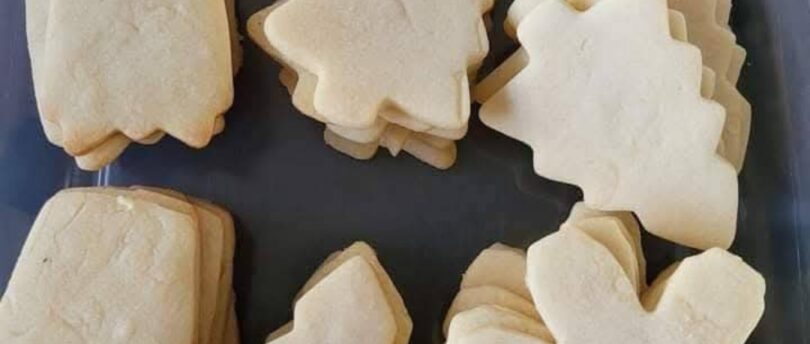A Timeless Recipe That Never Disappoints!
For over 35 years, we have been perfecting this classic shortbread recipe, ensuring it consistently delivers unmatched flavor and texture. With just three ingredients and a simple method, this shortbread recipe remains a favorite for bakers of all skill levels. Below, we provide a detailed guide, tips, and techniques to help you achieve flawless shortbread every single time.
Table of Contents
Why This Recipe Stands the Test of Time
Essential Ingredients for Perfect Shortbread
Step-by-Step Instructions
1. Cream Butter and Sugar
2. Incorporate the Flour
3. Roll Out the Dough
4. Cut into Shapes
5. Bake to Perfection
6. Cool and Enjoy
Pro Tips for Exceptional Shortbread
1. Use Cold Butter for Better Texture
2. Avoid Overmixing
3. Chill the Dough Before Baking
4. Experiment with Flavors
Creative Shortbread Variations
1. Chocolate-Dipped Shortbread
2. Festive Additions
3. Savory Shortbread
Storage and Serving Tips
Why This Recipe Will Always Delight
Why This Recipe Stands the Test of Time
Shortbread is a quintessential treat that combines simplicity and elegance. This recipe, built on a foundation of powdered sugar, butter, and flour, creates a velvety dough and a buttery cookie that melts in your mouth. Here’s why it works:
Perfect Balance: The precise ratio of sugar, butter, and flour ensures a delicate crumb and melt-in-your-mouth texture.
Versatility: Suitable for any occasion, from afternoon tea to festive celebrations.
Proven Success: Over three decades of refinement have confirmed this recipe as foolproof.
Essential Ingredients for Perfect Shortbread
To achieve the perfect texture and flavor, it’s important to use high-quality ingredients. Here’s what you need:
Powdered Sugar (1 cup): Provides a smoother texture compared to granulated sugar, ensuring a soft, tender bite.
Unsalted Butter (2 cups): Butter is the star ingredient in shortbread. High-quality, room-temperature butter enhances flavor and creates a luxurious texture.
All-Purpose Flour (3 cups): A light, fine flour is essential for achieving the delicate crumb. Be sure to sift the flour for consistent results.
Step-by-Step Instructions
1. Cream Butter and Sugar
Place the butter and powdered sugar into a large mixing bowl.
Using a stand mixer or hand mixer on medium-high speed, beat the mixture until it becomes light and fluffy, approximately 3–5 minutes. This process incorporates air into the dough, giving the shortbread its signature tenderness.
2. Incorporate the Flour
Gradually add the flour, one cup at a time, to the creamed mixture. Continue to beat on low speed until fully incorporated.
Increase the mixer speed to medium and beat the dough for an additional 5 minutes. The dough should feel velvety and soft to the touch when ready.
3. Roll Out the Dough
Lightly flour your work surface to prevent sticking.
Roll out the dough to your desired thickness. For traditional shortbread, aim for about ¼ inch thickness.
4. Cut into Shapes
Use cookie cutters or a knife to cut the dough into desired shapes. Classic rectangles or festive shapes add visual appeal.
Arrange the cutouts on a parchment-lined baking sheet, leaving space between each piece to prevent spreading.
5. Bake to Perfection
Preheat your oven to 350°F (175°C).
Bake the shortbread for approximately 7–9 minutes, or until the edges are lightly golden. Avoid overbaking to maintain the delicate texture.
6. Cool and Enjoy
Allow the shortbread to cool on the baking sheet for 5 minutes before transferring to a wire rack.
Once completely cooled, enjoy the cookies as-is or dust with powdered sugar for added sweetness.
Pro Tips for Exceptional Shortbread
1. Use Cold Butter for Better Texture
While room-temperature butter works well, using slightly chilled butter can result in a firmer dough and more defined shapes.
2. Avoid Overmixing
Mixing the dough too long after adding flour can activate gluten, leading to tougher cookies. Stop as soon as the dough feels velvety.
3. Chill the Dough Before Baking
If your dough becomes too soft, refrigerate it for 15–20 minutes before rolling. This step prevents spreading during baking.
4. Experiment with Flavors
Add a touch of vanilla extract, lemon zest, or a pinch of sea salt to elevate the flavor profile of your shortbread.
Creative Shortbread Variations
1. Chocolate-Dipped Shortbread
After baking, dip half of each cookie in melted dark chocolate. Sprinkle with crushed nuts or sea salt for a gourmet touch.
2. Festive Additions
Incorporate finely chopped dried fruit or crushed peppermint candies into the dough for seasonal flair.
3. Savory Shortbread
Replace powdered sugar with finely grated Parmesan cheese and add a dash of rosemary for a savory twist.
Storage and Serving Tips
Storing: Keep your shortbread in an airtight container at room temperature for up to one week. For longer storage, freeze the cookies for up to three months.
Serving: Pair with tea, coffee, or hot chocolate for a delightful treat. Shortbread also makes an elegant gift when packaged in decorative tins.
Why This Recipe Will Always Delight
The timeless appeal of shortbread lies in its simplicity, versatility, and rich buttery flavor. Whether you’re baking for a special occasion or enjoying a quiet afternoon, this recipe ensures consistent, delightful results every time.







